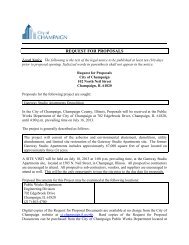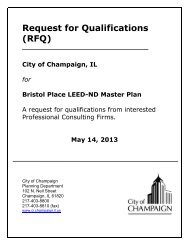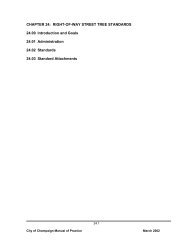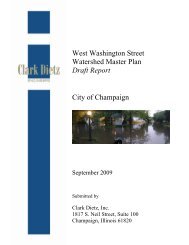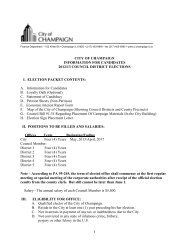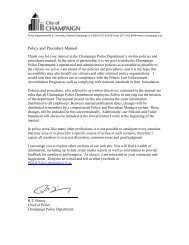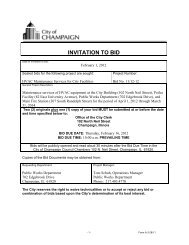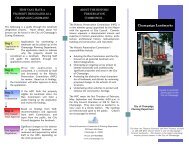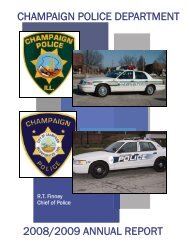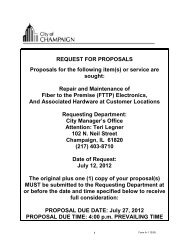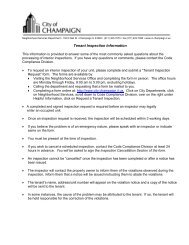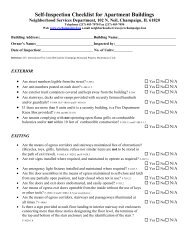2010-2014 Consolidated Plan - City of Champaign
2010-2014 Consolidated Plan - City of Champaign
2010-2014 Consolidated Plan - City of Champaign
You also want an ePaper? Increase the reach of your titles
YUMPU automatically turns print PDFs into web optimized ePapers that Google loves.
oooooSpalding Park: waterline replacement (drinking fountain), pool repairs, bathhouse repairsBristol Park: fencingHazel Park: playground replacementDouglass Center: HVAC, perimeter fence/gateDouglass Annex: HVACHealth Care FacilitiesCommunity Health Improvement Center/Frances Nelson Health CenterThe mission <strong>of</strong> the Frances Nelson Health Center is to provide affordable and accessible, high qualitycomprehensive health care services to the medically underserved population <strong>of</strong> the <strong>Champaign</strong> Countyareas. The Center provides comprehensive primary health care services, including preventive services,immunizations, breast and cervical cancer screenings, diagnosis and treatment <strong>of</strong> acute and chronicdiseases, prenatal care, on-site lab services and referrals for specialty care. With the help <strong>of</strong> CDBGfunding from the Cities <strong>of</strong> <strong>Champaign</strong> and Urbana, FNHC relocated to a larger site at 819 BloomingtonRoad, <strong>Champaign</strong>, in 2006.<strong>Champaign</strong>-Urbana Public Health DistrictThe <strong>Champaign</strong>-Urbana Public Health District (CUPHD) was formed by referendum in 1937 to establishpublic health services for Cunningham Township (the <strong>City</strong> <strong>of</strong> Urbana) and the <strong>City</strong> <strong>of</strong> <strong>Champaign</strong>Township (the <strong>City</strong> <strong>of</strong> <strong>Champaign</strong>). Simply stated, the agency’s mission is “to improve the health <strong>of</strong> the<strong>Champaign</strong> County community.” This is achieved by preventing disease, injury and disability; promotinghealthy living; and providing early diagnosis <strong>of</strong> disease to improve health outcomes (and reduce healthcare costs). CUPHD provides a wide range <strong>of</strong> preventive health services for the entire community, e.g.,environmental health inspections <strong>of</strong> restaurants and grocery stores, vision & hearing screening forchildren in schools and pre-schools, health education, etc. CUPHD also provides the following preventiveprimary health care services predominantly to low-income clientele: pregnancy testing, prenatal casemanagement/support, WIC supplemental nutrition program, well baby check-ups, immunizations, schoolphysicals, dental services for children, Health Checks (which check blood pressure, blood cholesterol, andblood sugar levels), a Sexually-Transmitted Disease clinic, HIV and Hepatitis screening, “Wellness onWheels” mobile preventive health services, and more. CUPHD moved to its current location at 201 W.Kenyon Road, <strong>Champaign</strong> in 2007, allowing all services to be consolidated at one site.SECTION 4B: PUBLIC IMPROVEMENTSInfrastructureThe <strong>City</strong> <strong>of</strong> <strong>Champaign</strong> builds, maintains and rehabilitates ten infrastructure systems - alleys, bridges,parking, sanitary sewers, sidewalks, storm sewers and drainage, streetlights, streets, traffic signs andsignals, and urban forest. The <strong>City</strong> implemented standards for the development <strong>of</strong> new neighborhoods,where most <strong>of</strong> the basic infrastructure systems must be provided as a part <strong>of</strong> the new development.However, the older areas <strong>of</strong> the <strong>City</strong> which include many <strong>of</strong> the lower-income neighborhoods, may notmeet the <strong>City</strong>’s current standards.The quality <strong>of</strong> the <strong>City</strong>’s infrastructure systems contributes to the quality <strong>of</strong> life for residents in terms <strong>of</strong>appearance, health and safety. Failing systems, such as sanitary and storm sewers, can damageproperty and discourage residents from choosing to live in certain areas. Other systems, such assidewalks, alleys, and streets, can become an impediment for the elderly and persons with disabilities ifnot properly maintained. As neighborhoods age, infrastructure systems require greater effort and cost toimprove and repair.Needs Assessment: Non-Housing Community Development 55



